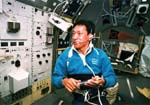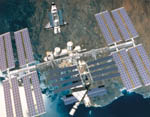
History of Japan's manned space activities
In 1985, three people, Mamoru Mohri, Chiaki Mukai, and Takao Doi, were selected as NASDA's(JAXA's) first generation of astronauts who would conduct space experiments.
Mamoru Mohri flew aboard the Space Shuttle (STS-47/FMPT) for the first time as a Japanese astronaut in March 1992. Since then, NASDA(JAXA) has been accumulating experience in manned space activities. Based on this experience, Japan hopes to contribute to constructing and operating the International Space Station (ISS) and Japanese Experiment Module (Kibo). The construction of the ISS began in late 1998, and Kibo will be attached to the ISS from 2006 to 2007.
From the viewpoint of manned space activity, the period of 15 years from 1992, when a Japanese astronaut first flew in space aboard a Space Shuttle to the completion of Kibo in 2007 can be categorized in three phases.
First phase: Learning about the space environment through space experiments.
In the first phase, NASDA(JAXA) participated in NASA's Space Shuttle missions in which manned space experiments were conducted in order to prepare for full-scale manned space activities to come during ISS operation. Through the FMPT conducted aboard STS-47 held in 1992 and through the IML-2 conducted aboard STS-65 in 1994, NASDA(JAXA) was able to acquire basic knowledge for transporting humans to space, and to conduct research and development of technologies needed for space experiments utilizing microgravity.
- Japan's first manned space experiment with primary emphasis on material experiments:
From Sep. 12 to 20, 1992, (eight days), Mamoru Mohri, who has experience as a material scientist, flew aboard Space Shuttle Endeavour as a PS. During this period, he conducted 34 space experiments proposed by Japanese researchers in the fields of material and life science. NASDA(JAXA) conducted Japan's first manned space experiments during the FMPT mission. During this process, NASDA(JAXA) gained experience in astronaut selection and training for space experiments, development of space experiment devices, astronaut health control, and ground support and learned related technologies.
|
 |
- Manned space experiments focusing on life science and supported by international cooperation:
From Jul. 9 to 23, 1994 (16 days), Chiaki Mukai, an experienced surgeon, flew aboard Colombia as a PS and participated in theIML-2 mission. IML-2 was an international mission in which seven space agencies of 13 countries including Japan, the US, Europe, and Canada, provided experiment devices and themes. NASDA(JAXA) offered six experiment devices and conducted 12 experiments, primarily in the field of life science, which were proposed by Japanese researchers. Through this mission, NASDA(JAXA) successfully accumulated experience in manned space experiments supported by international cooperation.
|
 |
Second phase: Accumulating technologies through Robotics and Extra Vehicular Activities.
In order to prepare for assembling and operating the International Space Station, Japan's astronauts were allowed to become mission specialists (MSs). An MS is an all-round astronaut who operates shuttle systems or performs Extravehicular Activities (EVA) as well as payload operation; a PS conducts space experiments utilizing the special payloads on board the Shuttle.
Through the missions of astronauts Mohri and Mukai, NASDA(JAXA) accumulated space experiment experience. In the second step, NASDA(JAXA) proceeded to accumulate basic technologies necessary for overall manned space activities, such as operating manned systems or conducting EVAs through the participation of Japanese MSs of STS-72 and STS-87 missions.
- Acquisition of system operation technology utilizing robotics:
As the first Japanese MS, astronaut Koichi Wakata flew on Space Shuttle mission STS-72 from Jan. 11 to 20, 1996. He operated the robot arm and recovered the Japanese Space Flier Unit (SFU). Beginning from the selection of astronauts (Mission Specialist) in preparation for assembling and operating the ISS, NASDA(JAXA) accumulated experience of high level Shuttle operation technology training such as rendezvous or robot arm operation.
|
 |
- Acquiring technology for Extravehicular Activities:
During the STS-87 mission (Nov. 19 to Dec. 5, 1997), Takao Doi became the first Japanese astronaut to conduct an EVA.
He evaluated the devices and procedures to be used for assembling and maintaining the ISS. In addition, he captured a satellite by hand, an activity which had not been planned. Along with Wakata's robot arm operation, EVA technology is vital for conducting the ISS assembly, space experiments or system operations during long-term ISS activities to follow. NASDA(JAXA) accumulated precious experience from the success of the mission, which means a major step was made for the success of the ISS program.
|
 |
Third phase: Contribution to the ISS program
 The ISS assembly began in late 1998. Components will be launched on more than 40 flights using Space Shuttles and Russian rockets. After ISS assembly is completed, it will be utilized for more than 10 years as a multi purpose laboratory in space. The ISS assembly began in late 1998. Components will be launched on more than 40 flights using Space Shuttles and Russian rockets. After ISS assembly is completed, it will be utilized for more than 10 years as a multi purpose laboratory in space.
NASDA(JAXA) acquired manned technology for space experiments in the first phase and overall technology for manned space activity during the second phase. With these bases, NASDA(JAXA) is going to contribute to the ISS program through Japanese astronauts' participation in the assembly and operation of the ISS.
Astronaut Mukai flew aboard the STS-95 mission in October, 1998 as a Payload Specialist (PS) and conducted space medicine experiments. These experiments provide necessary information for long-term space stays in the future. Astronaut Wakata flew aboard the STS-92 mission in October 2000, the seventh ISS assembly flight, and participated in the ISS assembly by operating the robot arm.
The Japanese Experiment Module (Kibo) will be launched and assembled from 2006 through 2007. In order to prepare for the full operation of the ISS, NASDA(JAXA) started recruiting two astronauts in Feb.. 1998, and selected three candidates in Feb.. 1999. Two of them, Furukawa and Hoshide were certified as astronauts in January 2001, and Sumino was certified in September 2001.
In 2005, astronaut Noguchi is scheduled to fly aboard STS-114 and will participate in the ISS assembly.
Furthermore, JAXA is planning to construct technology bases for expanding activities for common people through ISS and Kibo utilization activities.
Last Updated : Jun. 7, 2004
|




 The ISS assembly began in late 1998. Components will be launched on more than 40 flights using Space Shuttles and Russian rockets. After ISS assembly is completed, it will be utilized for more than 10 years as a multi purpose laboratory in space.
The ISS assembly began in late 1998. Components will be launched on more than 40 flights using Space Shuttles and Russian rockets. After ISS assembly is completed, it will be utilized for more than 10 years as a multi purpose laboratory in space.